
1. The position of the FE line is determined by
the labor market and the production function. Labor supply and demand determine
equilibrium employment. Using equilibrium employment in the production function
gives the full-employment level of output. The FE line is vertical at
that point. The FE line shifts to the right if there is an increase in
labor supply or the capital stock or if there is a beneficial supply shock.
2. The IS curve shows
combinations of the real interest rate (r) and output (Y)
that leave the goods market in equilibrium. Equilibrium in the goods market
occurs when the aggregate supply of goods (Y) equals the aggregate demand
for goods (Cd
+
Id
+ G). Since desired national
saving (Sd) is
Y -
Cd
- G, an equivalent condition is
Sd
=
Id. Equilibrium is
achieved by the adjustment of the real interest rate to make the desired level
of saving equal to the desired level of investment. For different levels of
output, there are different desired saving curves, with different equilibrium
interest rates. When plotted on a figure showing output and the real interest
rate, this forms the IS curve, as shown in the Figure. The curve slopes
downward because as output rises, the saving curve shifts along the investment
curve and the real interest rate declines.

The
IS curve could shift down and to the
left if: (1) expected future output falls, because this increases desired
saving; (2) government purchases fall, because this increases desired saving;
(3) the expected future marginal product of capital falls, because this
decreases desired investment; or (4) corporate taxes increase, because this
decreases desired investment.
3.
The LM curve shows the combinations of output and the real
interest rate that maintain equilibrium in the asset market. Equilibrium in the
asset market occurs when real money demand equals the real money supply.
Figure 9.16 shows the derivation of the LM curve and why it slopes
upward. An increase in output from Y1 to Y2
raises money demand, shifting the money demand curve from MD(Y1)
to MD(Y2). With money supply fixed at MS, there
must be a higher real interest rate to get equilibrium in the asset market. This
gives two points of the LM curve, plotted on the right half of the
figure. The result is that higher output increases the real interest rate along
the LM curve, so the LM curve slopes upward.
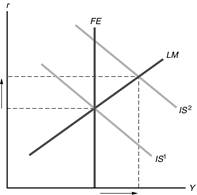
The LM curve would shift down and to the right if the nominal
money supply or expected inflation increased or if the price level or nominal
interest rate on money decreased. In addition, the curve would shift down and to
the right if there were a decrease in wealth, a decrease in the risk of
alternative assets relative to the risk of holding money, an increase in the
liquidity of alternative assets, or an increase in the efficiency of payment
technologies.
4. General equilibrium is a
situation in which all markets in an economy are simultaneously in equilibrium.
This is shown in Figure below as the point at which the FE line and the
IS and LM curves intersect. If the economy is not initially in
general equilibrium, output and the real interest rate are determined by the
intersection of the IS and LM curves. Then adjustment of the price
level moves the LM curve until it intersects the FE line and IS
curve.

5.
There is monetary neutrality if a change in the nominal money supply
changes the price level but has no effect on real variables. Once prices adjust,
money is neutral in the IS–LM model, because a change in the money supply
that shifts the LM curve is matched by a proportional change in the price
level that returns the real money supply back to its original level and moves
the LM curve back to its original location. Classical economists believe
that money is neutral in the short run, but Keynesians believe that there may be
sluggish adjustment of the price level, so that changes in the money supply
affect output and the real interest rate in the short run. Both classicals and
Keynesians believe money is neutral in the long run.
6. (a)
The increase in desired investment
shifts the IS curve up and to the right, as shown in Figure. The
price level rises, shifting the LM curve up and to the left to restore
equilibrium. Since the real interest rate rises, consumption declines. In
summary, there is no change in the real wage, employment, or output; there is a
rise in the real interest rate, the price level, and investment; and there is a
decline in consumption.
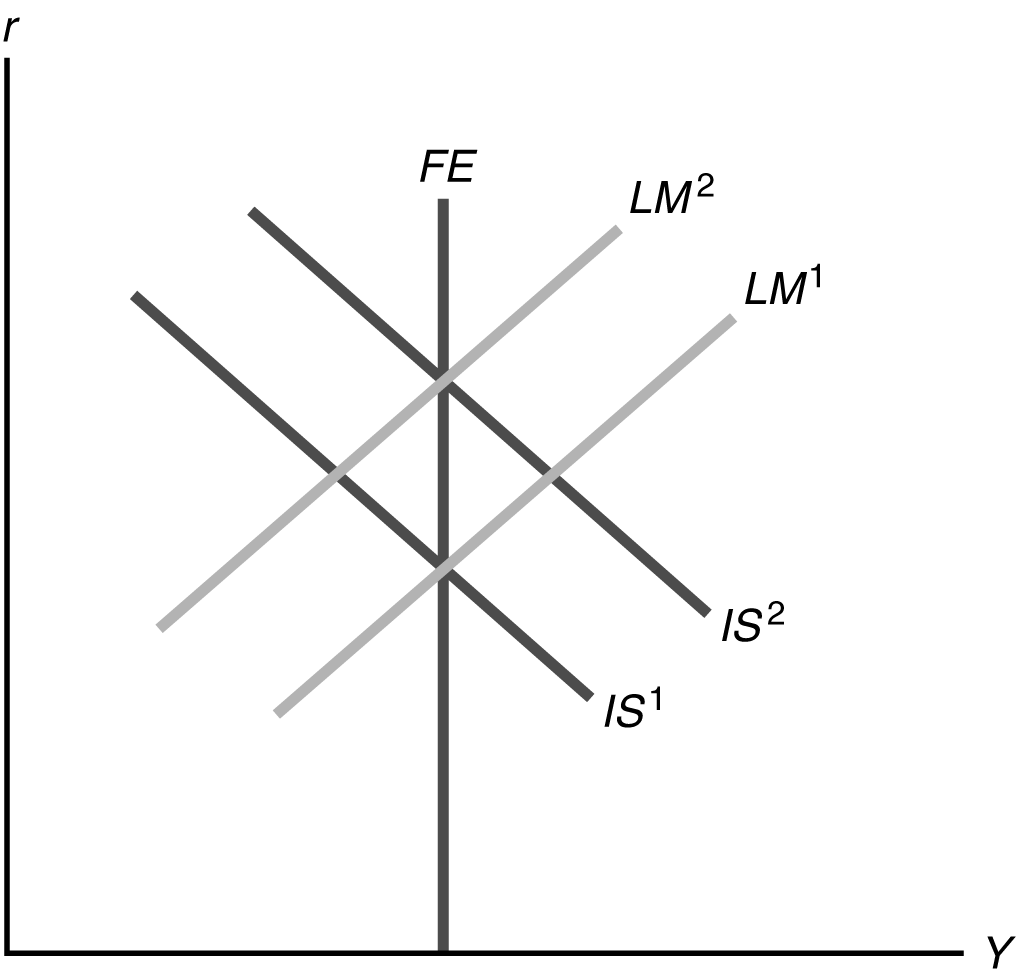
(b)
The rise in expected inflation shifts the LM curve down and to the
right, as shown in Figure. The price level rises, shifting the LM curve
up and to the left to restore equilibrium. Since the real interest rate is
unchanged, consumption and investment are unchanged. In summary, there is no
change in the real wage, employment, output, the real interest rate,
consumption, or investment; and there is a rise in the price level.
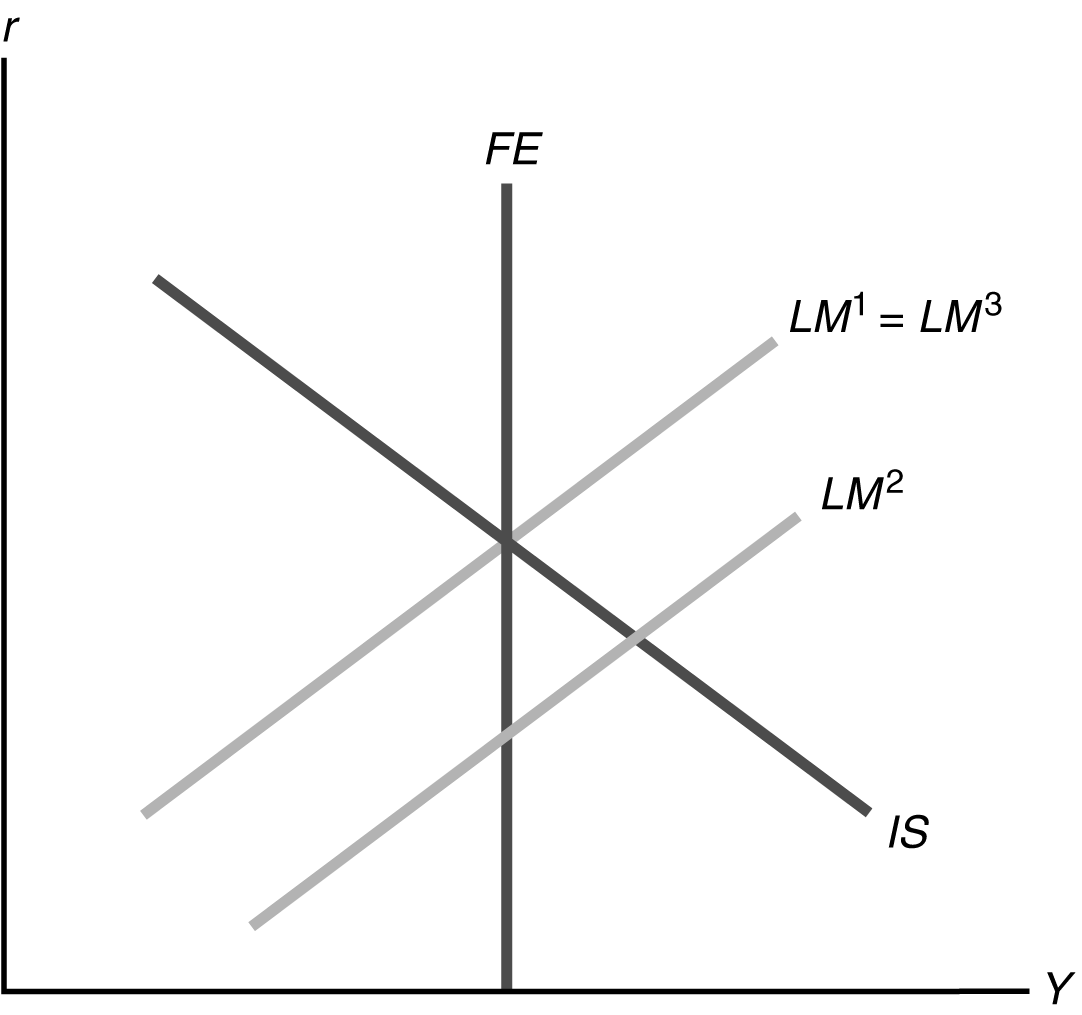
(c)
The increase in labor supply is shown as a shift in the labor supply
curve.
This leads to a decline in the real wage rate and an increase in employment. The
rise in employment causes an increase in output, shifting the FE line to
the right in Figure (b).
To restore equilibrium, the price level must decline, shifting the LM
curve down and to the right. Since output increases and the real interest rate
declines, consumption and investment increase.
In summary, the real wage, the real interest rate, and the price level decline;
and employment, output, consumption, and investment rise.

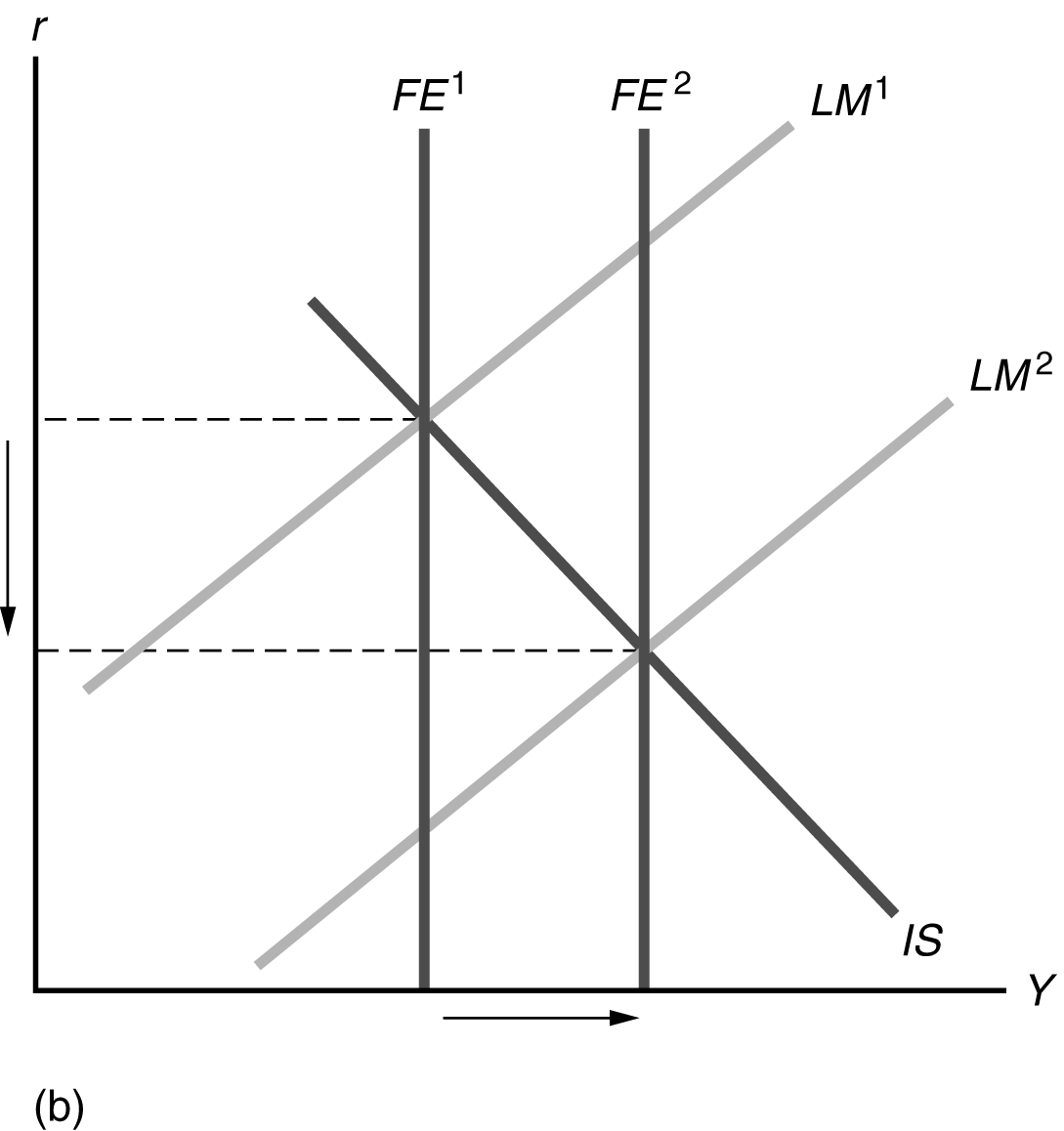
(d) The reduction in the demand for
money gives results identical to those in part (b).
2.
The increase in the price of oil reduces the marginal product of labor,
causing the labor demand curve to shift to
the left from ND1 to ND2 in Figure. Since
households’ expected future incomes decline, labor supply increases,
shifting the labor supply curve from NS1 to NS2
(but by assumption, the shift to the left in labor demand is larger than the
shift to the right in labor supply)*. At equilibrium, there is a reduced real
wage and lower employment. The productivity shock results in a shift to the left
of the full-employment line from FE1 to FE2
in Figure, as both employment and productivity decline. Because the shock is
permanent, it reduces future output and reduces the future marginal product of
capital, both of which result in a downward
shift of the IS curve. The new equilibrium is located at the
intersection of the new IS curve and the new FE line. If, as shown
in the figure, this intersection lies above and to the left of the original
LM curve, the price level will increase and shift the LM curve upward
(from LM1 to LM2) to pass through the new
equilibrium point. The result is an increase in the price level, but an
ambiguous effect on the real interest rate. Since output is lower, consumption
is lower. Since the effect on the real interest rate is ambiguous, the effect on
saving and investment are ambiguous as well, though the fall in the future
marginal product of capital would tend to reduce investment.
* It is questionable whether this second factor should be shifted now or later.


The result is different from that of a temporary supply shock; when the
shock is temporary there is no impact on future output or the marginal product
of capital, so the IS curve does not shift. In that case the price level
increases to shift the LM curve up and to the left from LM1
to LM2 in Figure 9.26 to restore equilibrium. In that case,
the real interest rate unambiguously increases. Under a permanent shock, the
IS curve shifts down and to the left, so the rise in the real interest rate
is less than in the case of a temporary shock, and the real interest rate can
even decline.
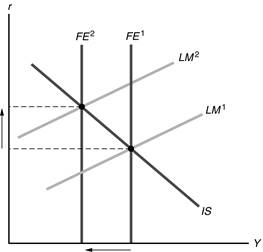
(a) The decrease in expected
inflation increases real money demand, shifting the LM curve up, as shown
in Figure. The real interest rate rises and output declines.

(b)
The increase in desired consumption shifts the IS curve up and to
the right, as shown in
Figure. This causes the real interest rate and output to rise.

(c) The increase in government
purchases shifts the IS curve up and to the right, with the same result
as in part (b). (The FE line also
shifts, as the increase in government expenditures reduces people’s wealth and
leads them to increase labor supply, but this shift will not affect the
short-run equilibrium, as the economy will be off the
FE line.)
(d)
If Ricardian equivalence holds, the increase in taxes has no effect on
either the IS or LM curves, so there is no change in either the
real interest rate or output. If Ricardian equivalence doesn’t hold, so that the
increase in taxes reduces consumption spending, the IS curve shifts down
and to the left, as shown in Figure. Both the real interest rate and output
decline.
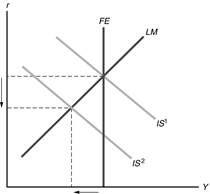
(e)
An increase in the expected future marginal productivity of capital
shifts the IS curve up and to the right, with the same result as in part
(b).